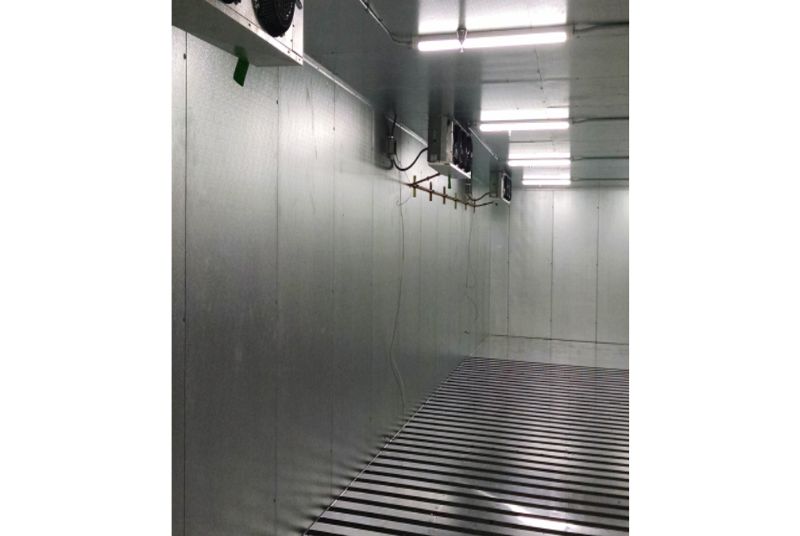Ice build up in walk-in freezers is not a good thing. The presence of ice in your walk-in can impact food quality and force your refrigeration equipment to work twice as hard to maintain the right temperature.
“Why having ice build-up in a walk-in freezer is a concern?”
Ice build-up can seem harmless but in reality, it can have a considerable negative impact not only to your walk-in freezer but also to your stored goods. In general, increased ice volume creates the potential for melting and refreezing of ice accumulation on the items stored in your walk-in freezer, possibly damaging product or reducing storage life. It can also greatly affect operation of the refrigeration equipment, especially your evaporator fan. Ice blockages can restrict airflow through the coil and prevent it from functioning correctly, leading to immediate performance issues.
“What causes ice build-up in my walk-in freezer?”
Ice build-up can come from a wide variety of sources. Listed below are some of the most common causes for ice build-up inside a walk-in freezer.
- Leaving the door open: Leaving the freezer door open while moving inventory in and out of it allows large volumes of warm, humid air to enter. The moisture in this air freezes and sticks to all the surfaces in your walk-in, adding to the ice in your freezer.
- Door not sealing correctly: In instances where the door doesn’t close or seal correctly due to worn gaskets, broken hinges or a malfunctioning latch, infiltration of warm and humid air can occur throughout the day, which can result in significant frost or ice build-up inside the freezer. Issues that affect the ability of the door to close and seal completely should be addressed immediately.
- Broken pressure relief port: Walk-in freezers use a heated pressure relief port to prevent pressure build-up or a vacuum from occurring. However, if the freezer’s doors are challenging to open or doesn’t close completely, it can be a sign of malfunctioning vent.
- Gasket failure: Damaged panel gaskets prevent your freezer from sealing correctly at the panel joints. If this happens, outside air can continuously enter through the cracks on your fridge. Cracks and rips in your gasket, together with separations between freezer panels, are common areas of damage that you should watch out for. If compromised gaskets are not addressed, ice accumulation in panel joints can greatly reduce the service life of your freezer.
- Clogged or frozen drain line from the evaporator coil(s): Frozen drain lines will not allow the water, created as ice is melted from the coil during the defrost cycle to be removed from the evaporator drain pan. The water can then be picked up and or blown out into the freezer when the system turns back on causing ice to form on the ceiling walls, floor, and all over the product Any water left in the drain pan will eventually re-freeze and during subsequent defrost cycles cause the pan to overflow as ice is melted off the coil fins creating more ice build-up and a potential slip hazard.
- Lack of Strip Curtain/Broken Strip Curtain: Strip curtains will limit the amount of moist air that enters the freezer when the door is open. Limiting air infiltration helps prevent warm, humid air from entering the walk-in.
- Check the Relative Humidity Percentage: Make sure that the RH% in the surrounding ambient air is low. Sufficient HVAC / a conditioned environment in the back rooms and or around your freezer will keep the RH% within ASHRAE norms and will limit icing issues.
Other than the items listed above, you can also get ice build-up from fan delay relay failure or defective defrost clocks.
“What should I do to prevent ice build-up in my walk-in freezer?”
Regular inspections can go a long way in making you aware of any potential ice build-up in your walk-in. You must go over the prime suspects that can cause ice build-up, such as the gaskets and the door’s components. Have a qualified professional check if the pressure relief port is working accurately and clear away any ice blocking it. Inspection of the refrigeration equipment, drain lines and heaters by a qualified professional should be performed as part of a regular maintenance program.
Conclusion
Although avoidance is optimal, you may have the occasional maintenance issue from ice build-up. You should hire a qualified technician to perform repairs and maintenance on your unit.
At KPS Global, we provide high quality walk-in cooler parts for businesses all around the US. Browse through our products today to find the perfect solution for your walk-in freezer’s needs!

